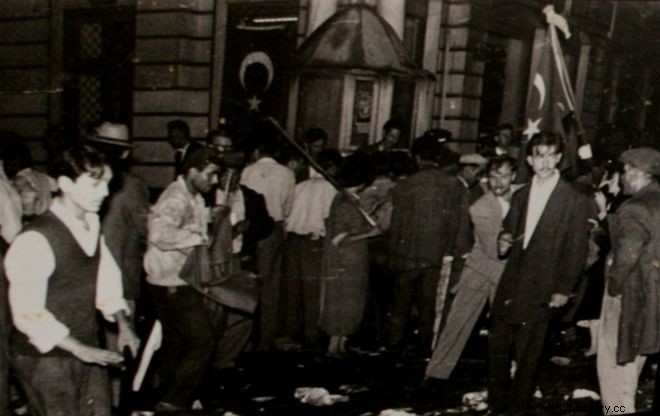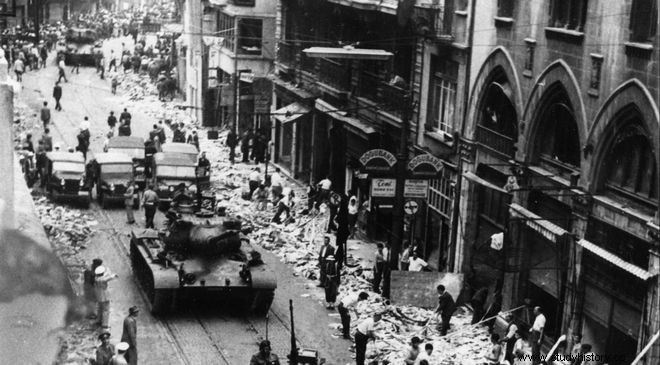A few weeks ago and on the occasion of the conversion of Hagia Sophia into a mosque, Greek nationalists called via social media for "intervention for the conversion of Kemal's house in Thessaloniki into a church".
Exactly 55 years ago, a falsified news story published in the newspaper Instabul Ekspres, and concerning the house of Kemal Atatürk, led to nationalist extremism and mass violence against the Greeks and Armenians of the city. Quite simply because nationalism and blind violence do not know borders and races. When, however, they are done with "state auspices", things go beyond all logic.
So on the night of September 6, 1955, over 100,000 Turkish nationalists poured into the streets destroying houses and churches, shops and property, killing and raping.
The occasion was, as we said, a fake publication, a creation of Istanbul Ekspres, which hosted a falsified photo of Kemal Atatürk's house in Thessaloniki, writing that Greeks planted an explosive device, causing great damage.
In fact, as the perpetrator of the attack, the Greek authorities arrested Oktai Egin, a Muslim student from Komotini, who declared himself a "victim of the Greek authorities".
The explosion only caused material damage to the windows of the house, but the Turkish newspapers took advantage of the occasion, exaggerating the event.
The official justification of the Turkish state was that people spontaneously poured into the street in reaction to alleged imminent executions of Turkish Cypriots. The propaganda machine had caught fire, mainly through the Hurriyet newspaper.

The shocking testimony of Dimitris Kaloumenos and the involvement of the English
Dimitris Kaloumenos has gone down in history as "the photographer of the Septembrians". He himself was a correspondent for "Ethnos", "Macedonia" and a photographer for the Ecumenical Patriarchate, who was expelled from Turkey in 1957.
At the risk of his life, he went out on the night of the riots and began to capture the moments when the crowd went to extremes. He secretly disposed of the films at the Greek Orthodox Cemetery of the Transfiguration of the Savior in Sisli and eventually, the material traveled to Greece.
In a rare interview he granted a few months before his death to Nikolaos Maghina in 2005 for "Light of the Lantern", he said, among other things, highlighting the involvement of the British:
"I also went to the Monastery of Valouklis where they burned it, I also went to the Hospitals of Valouklis. I took pictures of Bishop Pamfilos Gerasimos and priest Epiphanios, who wanted to pierce his hands... There, in Ypsomathea, near Yendikule, I ask a soldier :"What's going on here?" And he said to me:"What can I do, Effendi, I'm sitting and waiting. Yesterday they had me in (civilian) clothes and I was breaking down, today they made me wait".... Everything was prescribed to perfection. The English and the Turks knew everything"...

"The September events were an Anglo-Turkish affair. Due to the Cyprus tragedy, the people of Constantinople paid for the destruction. After all, in his recent book Spyros Vryonis, Professor, confirms that the Turks, the English and the Americans tried to keep silent about the destruction of Rome This, of course, the disaster was an opportunity for the Turks, who had laid out the program of dissolution, the program of the extermination of the Hellenism of Constantinople, led by İsmet İnönü, who İnönü did the recruitment, did the "Barliki", and all the evils that were done against Rome, came from him.
England, in order not to give Cyprus to Greece, created the conference of the "Three" in London. There he also invited Zorlu, the Turkish Foreign Minister. Before Zorlu the Minister of Foreign Affairs was Köprülü. When the issue of Cyprus came up, England came out and said to Turkey:"Come, take part." But Köprülü had replied that:"Turkey does not sacrifice friendship with Greece for Cyprus, which, after all, it gave you".
The English did not like this policy of Köprülü. They were introduced to Menderes, he expelled Köprülü and brought in Zorlu, who was Anglophile and money-loving. This is how the program was created together. England allocated at that time, in 1950, 1 million Turkish Lira - I worked in the old years, since the war, in the English Embassy and I had learned that it did give it - and Hürriyet began to write articles against Greece. Its circulation from 30 thousand leaves that was daily, immediately rose to 100 to 120 thousand leaves.
When the other newspapers saw that the circulation against Greece was increasing, they began to copy it, while the hostility was reduced with the growth of Greek-Turkish friendship:with the arrival of the Kings in the City and Celal Bayar in Greece, Greek-Turkish friendship had prevailed.
On August 30, 1955, the session took place, which failed. Greece did not want Turkey to participate and the session failed. That evening, Zorlu gave a press conference at the Turkish Embassy and stated that:"Greece became the cause of the breakdown of the conference and for this reason it will regret it". At the same time, Adnan Menderes delivered a speech on August 30, 1955, which is the day of celebration in Turkey for the liberation of Smyrna, at the "Liman lokantası" ("Limin" restaurant) on the dock of Constantinople and said that:"Greece will repent and suffer what the Greeks suffered in Smyrna". The atmosphere was thus very excited and electrified".

Dilek Guven's testimony
The British instigation of the Greek-Turkish confrontation was studied by Turkish historian Dilek Guven. In an interview he gave to the Armenian journalist Hrad Dink, before he was murdered by the far-right parastatals of "Ergenekon", he referred in detail to this involvement. The interview was republished in the Constantinople newspaper "Anatoli" and was saved by the historical scholar, Vlasis Agtzidis.
"The main cause seems to be the Cyprus issue, but in reality it is the period of building a national state. We can start with the population displacements of 1915, the Property Tax, the events in Thrace. They are all from the same period. During the Septembers, they were not only hit the Romans. If we look at the numbers, it is 60% Romans, 20% Armenians, 12% Jews. The non-Roma percentage is not accidental. In the lists they kept there were also Armenian shops and Armenian families. If we limit the cause to the Cypriot, what business did the Armenians have in the lists?
(…) When in 1950 the Turkish Foreign Minister said that "there is no issue of Cyprus for us", the British did not take it well, because at that time Cyprus was their colony. The whole world was against the government of England, and between 1950 and 1955 it had based its policy on how it would manage to draw Turkey into the problem and make it an interlocutor of Greece. That was her plan...
"(...) A year before the events of September, a telegram arrives at the British Foreign Ministry from the English consulate in Athens, which states:"The relations between Turkey and Greece are excellent. But if something happens to Ataturk's house in Thessaloniki , wonderfully everything can be done upside down".
"Isn't it interesting? There is such a document. In the organization of the events there is an English prompt. And the events are convenient for the English. In these events, for the attacks on the Armenians and the Jews, it is only mentioned that "Turks and Greeks were seized for the Cyprus issue".
What has not yet been clarified is the strange coincidence, that on the "night of the Constantinople crystals", all the heads of the secret services of the NATO countries were in the city, among them the head of the CIA, Alan Dulles.

The report
According to the calculations of the time, the demonstrations involved about 100,000 people who acted in groups of 15 to 50 people making "crude attacks". At the same time, they went in and out undisturbed in the crowd with the police and the army watching without intervening.
Thousands of Turks who did not live in the city participated in the pogrom and were transferred there for that reason.
In the days leading up to the pogrom, Greek shops and property had been painted with "GMR" to target the sites, while non-Muslim property had been listed before World War II.
Officially, the pogrom recorded 16 deaths of Greeks and serious injuries to 32 others, the death of an Armenian, 12 rapes of women, while an unknown number of men were forced to be circumcised.
At the same time, 4,348 shops, 110 hotels, 27 pharmacies, 23 schools, 21 factories, 73 churches, 1000 Greek homes were destroyed. According to international organizations, the world's losses reached 150 million dollars, while the Greek side increased the amount to 500,000,000 dollars. The result was that the Greeks of the city were left without jobs.
The 100,000 Greeks who lived in the city at that time began to shrink gradually and today barely exceed 2,000 people. The climax of the persecutions, of course, were the mass deportations of 1964 which constituted one of the most brutal violations of the Treaty of Lausanne.
The September events were attributed by Adnan Menderes' government to the communists (on September 9, more than 9,000 people of "communist beliefs" were imprisoned in Istanbul, including Aziz Nessim and Nazim Hikmet, bringing the number of prisoners to 5,104). A practice reminiscent of the blind prosecutions against "Gulenists" in recent years.
The Turkish state and President Celal Bayar promised compensation for the disasters. Of the applications submitted, only 20% were covered.
The end of Menderes
After all, Turkey's prime minister at the time of the pogrom and mastermind of the attack, Adnan Menderes, was arrested in 1961 after being overthrown by Cemal Gürcel's coup, and convicted of high treason and sent to the gallows.
The events of September 6 - 7, 1955 were indeed the "conviction" of Menderes.

After the incidents, the opposition was organized within his own party, the Democrats, while members left and formed the "Freedom Party". Republicans began pushing for his resignation as he stepped up crackdowns, attacks by paramilitary groups, censorship and control of the press, and increased jailings of political opponents. Intellectuals and students rose up against him while military personnel who considered themselves "Kemalists" decided to take action.
His trial, which lasted over 10 months, brought to light details of the pogrom. In addition to the prime minister, those sentenced to death included the President of the Republic Jelal Bayar, the Minister of Foreign Affairs Fatin Zorlu, the Minister of Finance Hasan Polatkan, the President and Vice President of the National Assembly Refik Koraltan, the Deputy Prime Minister Emin Kalafat, the parliamentary representative of party of Menderes, Baha Askit, three more MPs of this party etc. Thirty-one others were sentenced to life in prison. A few hours later, the regime's National Unity Committee decided to execute only Menderes, Zorlu and Polatkan, turning the death sentences of the remaining 12 into life imprisonment.
Adnan Menderes spoke Greek, English and French. The airport of Smyrna is named in his honor today, in a city that was also attacked against Greeks on the night of September 6, 1955.
Read the News from Greece and the world, with the reliability and validity of News247.gr.
